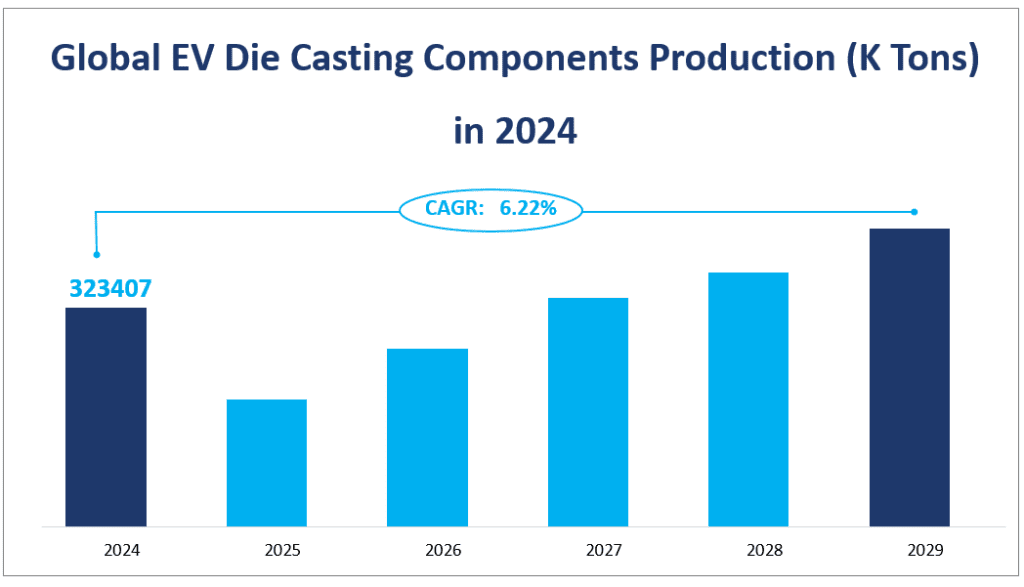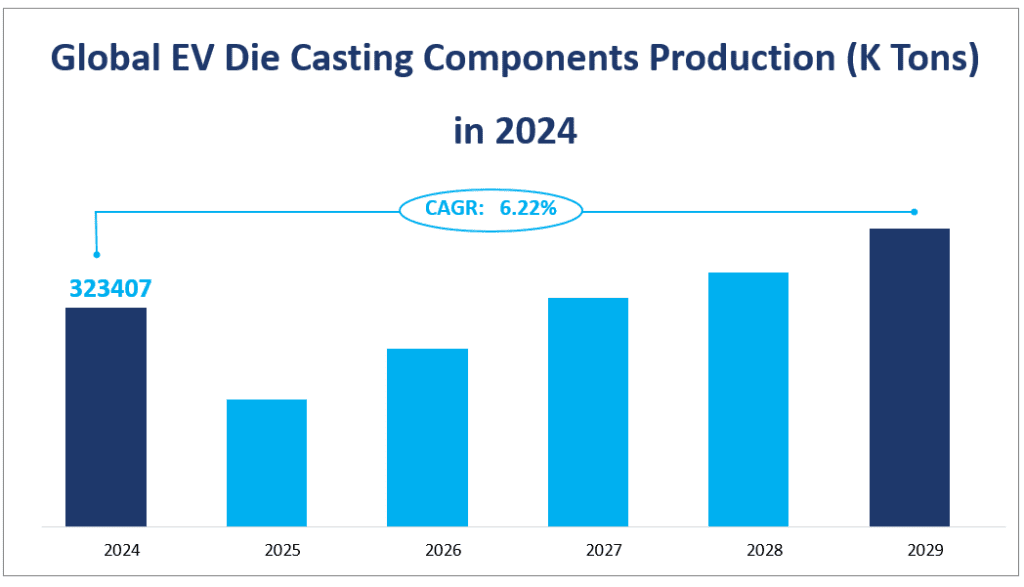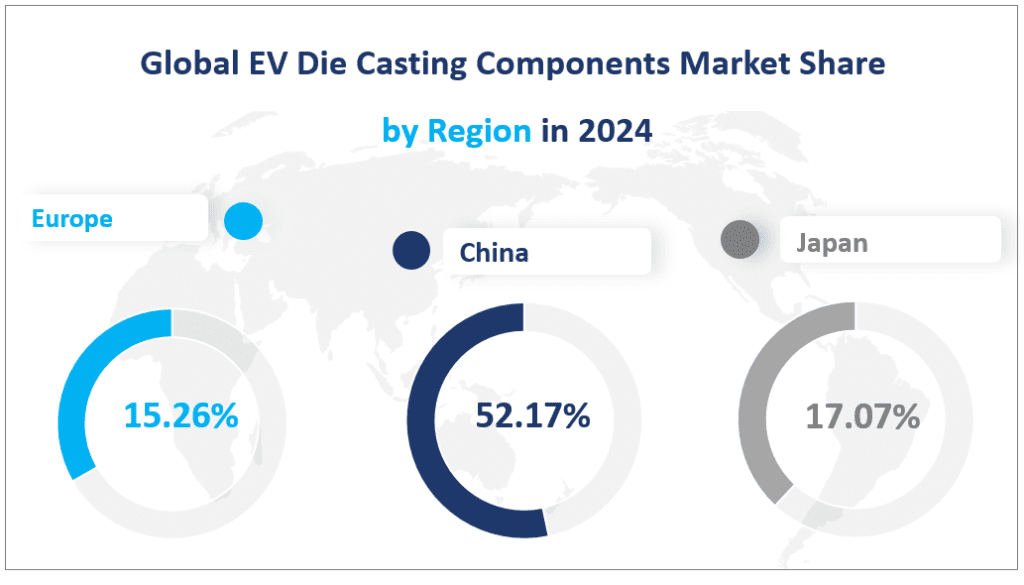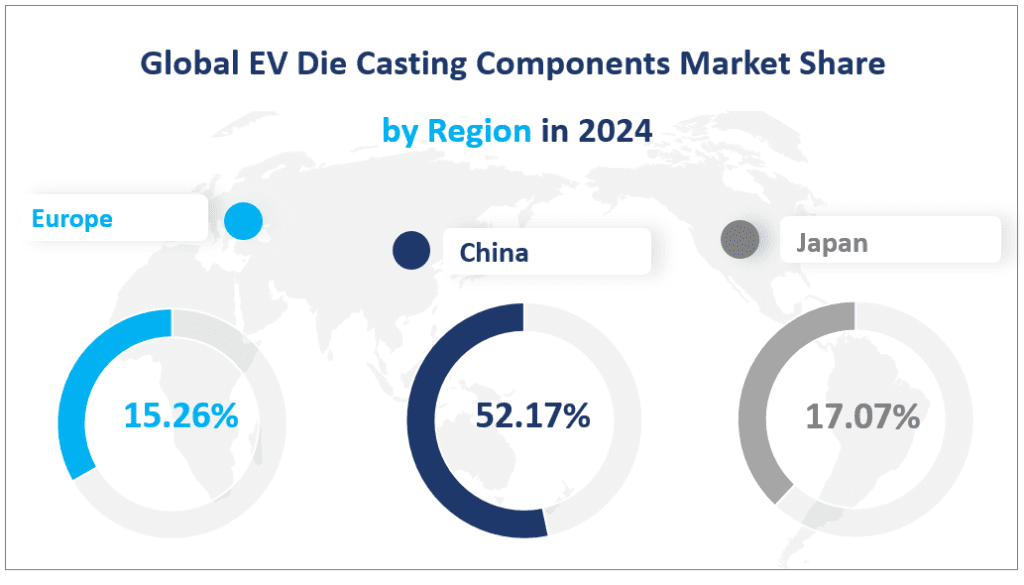1. Global EV Die Casting Components Market Prospects
In 2024, the global EV Die Casting Components market is projected to produce 2,070.4 K Tons with a CAGR of 44.20% from 2024 to 2029, indicating a period of rapid expansion and innovation in the sector.
EV Die Casting Components refer to the die castings used in electric vehicles. These components are crucial for the structural integrity and functionality of electric vehicles, encompassing a wide range of parts such as battery cases, motor housings, and structural frames.
The EV Die Casting Components market is not only driven by the increasing popularity of electric vehicles but also by the continuous advancements in die casting technologies. These technologies enable the production of complex and lightweight components, which are essential for improving the energy efficiency and performance of electric vehicles. The market is also characterized by a high degree of specialization, with companies focusing on specific types of die casting processes and applications.
Global EV Die Casting Components Production (K Tons) in 2024


2. Driving Factors of EV Die Casting Components Market
The growth of the EV Die Casting Components market is primarily driven by the global shift towards sustainable transportation. Governments around the world are implementing stringent environmental regulations to reduce carbon emissions, which has led to increased incentives for the adoption of electric vehicles. These incentives, such as tax breaks and subsidies, have made electric vehicles more affordable and attractive to consumers, thereby increasing the demand for EV Die Casting Components.
Another significant driving factor is the technological advancements in die casting. Innovations in materials and casting techniques have allowed for the production of lighter and stronger components, which are critical for enhancing the range and performance of electric vehicles. Additionally, the integration of die casting with other manufacturing processes, such as machining and assembly, has improved the efficiency of production lines, further boosting the market growth.
3. Limiting Factors of EV Die Casting Components Market Growth
Despite the positive outlook, the EV Die Casting Components market faces several challenges. One of the primary limiting factors is the fluctuation in raw material prices, particularly aluminum, which is the main material used in die casting. Price volatility can lead to increased production costs, affecting the profitability of manufacturers.
Moreover, the market is highly competitive, with a few dominant players holding a significant share. New entrants may find it difficult to penetrate the market due to the high capital investment required for advanced die casting equipment and the need for specialized technical expertise. Additionally, the electric vehicle market itself is still in a phase of rapid development, with changing consumer preferences and technological standards. This uncertainty can make it challenging for die casting component manufacturers to predict future demand accurately and invest in the right technologies and capacities.
4. Global EV Die Casting Components Market Segment
Product Type of EV Die Casting Components Market
High Pressure Die Casting (HPDC) is expected to lead the market with a production volume of 1,480.6 K Tons in 2024. HPDC is a process where molten metal is injected into a mold at high speed and pressure, allowing for the production of large light alloy parts in high volumes. This method is particularly suited for the manufacturing of complex and intricate components, such as engine blocks and transmission housings, which are essential for the performance and efficiency of electric vehicles
Gravity Die Casting (GDC) is projected to have a production of 274.9 K Tons in 2024. GDC involves pouring molten metal directly from a ladle into semi-permanent or permanent molds. This process is well-suited for the production of various complex aluminum castings for auto parts, such as turbochargers, brake calipers, steering knuckles, and engine cylinder heads. GDC is known for its ability to produce high-quality castings with good mechanical properties and surface finish.
Low Pressure Die Casting (LPDC) is anticipated to produce 224.5 K Tons in 2024. LPDC is a process commonly used in foundries today, where molten metal slowly fills the mold, reducing turbulence. This process is ideal for producing components such as wheels, suspension parts, steering components, and engine parts. LPDC offers several advantages, including the ability to produce near-net shape parts with excellent dimensional accuracy and reduced porosity.
In terms of market share, HPDC is the dominant product type, accounting for the largest portion of the market due to its versatility and ability to produce a wide range of components. However, when it comes to the fastest growing rate, LPDC is expected to outpace other types. This growth can be attributed to the increasing demand for lightweight and high-strength components in electric vehicles, where LPDC’s ability to produce complex geometries with excellent mechanical properties is highly valued.
Application Analysis of EV Die Casting Components Market
Passenger Vehicle is anticipated to have the largest market share with a production of 1607.6 K Tons in 2024. Passenger vehicles, which include cars and other light-duty vehicles, are the primary focus of the electric vehicle market. The demand for EV Die Casting Components in this segment is driven by the need for lightweight, efficient, and high-performance components that can enhance the driving range and overall performance of electric vehicles.
Two Wheeler is expected to produce 186.5 K Tons in 2024. The two-wheeler segment, comprising electric motorcycles and scooters, is growing rapidly due to the increasing awareness of environmental issues and the need for sustainable transportation options in urban areas. Die casting components for two-wheelers include frames, wheels, and other structural parts that require high strength and durability.
Commercial Vehicle is projected to have a production of 276.3 K Tons in 2024. Commercial vehicles, such as trucks and buses, are also adopting electric technology to reduce emissions and operating costs. The demand for die casting components in this segment is focused on producing robust and reliable parts that can withstand the heavy loads and rigorous operating conditions of commercial vehicles. Components such as axles, chassis parts, and battery support structures are essential for the performance and safety of commercial electric vehicles.
In terms of the fastest growing rate, the Two Wheeler application is expected to lead. This growth is attributed to rapid urbanization and the increasing demand for personal mobility solutions that are environmentally friendly and cost-effective. As more cities around the world implement policies to promote electric two-wheelers, the market for die casting components in this application is set to expand significantly.
| Market Production (K Tons) in 2024 | Market Share in 2024 | ||
| By Type | High Pressure Die Casting (HPDC) | 1,480.6 | 71.51% |
| Gravity Die Casting (GDC) | 274.9 | 13.28% | |
| Low Pressure Die Casting (LPDC) | 224.5 | 10.84% | |
| Others | 90.4 | 4.37% | |
| By Application | Two Wheeler | 186.5 | 9.01% |
| Passenger Vehicle | 1,607.6 | 77.65% | |
| Commercial Vehicle | 276.3 | 13.34% |
5. Regional EV Die Casting Components Market Segment
North America is expected to produce 203.9 K Tons of EV Die Casting Components in 2024. The region’s production is driven by the growing demand for electric vehicles and the presence of major automotive manufacturers. The United States, in particular, is a significant contributor to this production, with companies investing heavily in advanced manufacturing technologies to meet the increasing demand for lightweight and high-performance components
Europe is projected to produce 316.0 K Tons, making it a substantial player in the global market. Europe’s strong automotive industry, coupled with stringent environmental regulations and a push towards sustainable transportation, has led to a significant increase in the production of EV Die Casting Components.
China leads the pack with an expected production of 1,080.2 K Tons, accounting for over 50% of the global production. China’s dominance can be attributed to its vast manufacturing infrastructure, government support for the electric vehicle industry, and a strategic position as a global hub for automotive component manufacturing. The country’s ability to produce at scale, combined with its focus on research and development, has made it a key player in the EV Die Casting Components market. Additionally, China’s domestic market demand for electric vehicles is a significant driver of production, with the government’s policies promoting the adoption of electric vehicles and the expansion of charging infrastructure.
Other regions are expected to contribute 62.5 K Tons to the global production. These regions include emerging markets and countries with growing automotive industries that are beginning to focus on electric vehicle components.
Global EV Die Casting Components Market Share by Region in 2024


6. Top 3 Companies of EV Die Casting Components Market
RYOBI, established in 1943, is a global leader in die casting manufacturing. The company is headquartered in Hiroshima, Japan, and operates manufacturing plants primarily in North America, the UK, China, and Thailand. RYOBI’s business segments include die casting parts, builder’s hardware, printing equipment, and power tools. The company is renowned for its high-quality die casting products, which are used in various industries, including the automotive sector.
RYOBI offers a wide range of die casting products, including cylinder blocks, transmissions, subframes, and other chassis parts for the automotive industry. These products are designed to meet the stringent requirements of global automakers, focusing on lightweight and high-strength solutions.
Hitachi Metals, founded in 1956, is a Japan-based company with a diverse product portfolio. The company operates through four divisions: Advanced Metal Products and Materials, Magnetic Materials and Applications, Premium Functional Components and Equipment, and Wire, Cable and Related Products. Hitachi Metals is known for its innovation and quality, serving key markets such as infrastructure, automotive, and electronics.
Hitachi Metals specializes in producing aluminum battery cases for electric vehicles. These cases are designed to maximize capacity while reducing weight, featuring thin-walled, large-scale aluminum castings that achieve high rigidity and high airtightness. The company’s products are integral to the performance and safety of electric vehicles.
Ningbo Xusheng Auto Technology Co
Ningbo Xusheng Auto Technology Co, established in 2003, is a leading manufacturer of precision aluminum alloy auto parts and industrial parts. The company is based in China and serves a global market. Ningbo Xusheng is committed to the field of new energy vehicles and lightweight vehicles, focusing on research and development, production, and sales of precision components.
The company’s product range includes heavy truck clutch housings and other precision-machined parts for new energy vehicle transmission systems, batteries, and suspension systems. Ningbo Xusheng’s manufacturing processes cover die-casting, forging, and extrusion, providing comprehensive solutions for automotive power systems, chassis systems, and battery systems.
Major Players
| Company Name | Plant Locations | Market Distribution |
| RYOBI | Mainly in North America, UK, China, Thailand | Worldwide |
| Hitachi Metals | Mainly in Asia, USA | Worldwide |
| Ningbo Xusheng Auto Technology Co | China | Worldwide |
| KSM Castings Group | Mainly in Germany, Czech Republic, USA, and China | Worldwide |
| Guangdong Wencan Die Casting Co | China | Worldwide |
| Guangdong Hongtu Technology | China | Worldwide |
| DGS | Mainly in Switzerland, Czech Republic, China | Worldwide |
| Suzhou Chunxing Precision Mechanical Co | Mainly in China, USA, Poland, India | Worldwide |
| IKD Co | Mainly in China, Mexico | Mainly in America, Europe, Asia |
| Dongguan EONTEC Co | China | Mainly in Europe, America, Asia |
| GuangDong PaiSheng | China | Worldwide |
| EMP Tech Co | China | Worldwide |
| Chicago White Metal Casting, Inc | Mainly in US | Worldwide |
| Endurance | Mainly in Italy, Germany, India | Worldwide |
| Handtmann | Mainly in Germany, China | Worldwide |
| Nemak | Mainly in America | Worldwide |
| Gibbs Die Casting | Mainly in North America | Worldwide |
| Martinrea Honsel | Mainly in Mexico, Brazil, Spain, Germany, China | Worldwide |
| Dynacast | Mainly in Europe, North America, China | Worldwide |
1 EV Die Casting Components Market Overview
1.1 Product Overview and Scope of EV Die Casting Components
1.2 EV Die Casting Components Segment by Type
1.2.1 Global EV Die Casting Components Market Size Growth Rate Analysis by Type 2022 VS 2030
1.3 Market Analysis by Applications
1.3.1 EV Die Casting Components Consumption Comparison by Application (2017-2030)
1.4 Global Market Growth Prospects
1.4.1 Global EV Die Casting Components Revenue Estimates and Forecasts (2017-2030)
1.4.2 Global EV Die Casting Components Production Estimates and Forecasts (2017-2030)
1.5 Global Market Size by Region
1.5.1 Global EV Die Casting Components Market Size Estimates and Forecasts by Region: 2017 VS 2022 VS 2030
1.5.2 North America EV Die Casting Components Estimates and Forecasts (2017-2030)
1.5.3 Europe EV Die Casting Components Estimates and Forecasts (2017-2030)
1.5.4 China EV Die Casting Components Estimates and Forecasts (2017-2030)
1.5.5 Japan EV Die Casting Components Estimates and Forecasts (2017-2030)
1.5.6 India EV Die Casting Components Estimates and Forecasts (2017-2030)
2 Market Competition by Manufacturers
2.1 Global EV Die Casting Components Production by Manufacturer
2.2 Global EV Die Casting Components Revenue and Market Share by Manufacturer
2.3 Global EV Die Casting Components Average Price by Manufacturers
2.4 Manufacturers EV Die Casting Components Production Sites, Area Served
2.5 EV Die Casting Components Market Competitive Situation and Trends
2.5.1 EV Die Casting Components Market Concentration Rate
2.5.2 Global Top 5 and Top 10 Players Market Share by Revenue
2.5.3 Mergers & Acquisitions, Expansion
3 Production by Regions
3.1 Global EV Die Casting Components Retrospective Market Scenario in Production by Region: 2017-2022
3.2 Global EV Die Casting Components Revenue Market Share by Region 2017-2022
3.3 Global EV Die Casting Components Production, Revenue, Price and Gross Margin (2017-2022)
3.4 North America EV Die Casting Components Production
3.4.1 North America EV Die Casting Components Production Growth Rate (2017-2022)
3.4.2 North America EV Die Casting Components Production, Revenue, Price and Gross Margin (2017-2022)
3.5 Europe EV Die Casting Components Production
3.5.1 Europe EV Die Casting Components Production Growth Rate (2017-2022)
3.5.2 Europe EV Die Casting Components Production, Revenue, Price and Gross Margin (2017-2022)
3.6 China EV Die Casting Components Production
3.6.1 China EV Die Casting Components Production Growth Rate (2017-2022)
3.6.2 China EV Die Casting Components Production, Revenue, Price and Gross Margin (2017-2022)
3.7 Japan EV Die Casting Components Production
3.7.1 Japan EV Die Casting Components Production Growth Rate (2017-2022)
3.7.2 Japan EV Die Casting Components Production, Revenue, Price and Gross Margin (2017-2022)
3.8 India EV Die Casting Components Production
3.8.1 India EV Die Casting Components Production Growth Rate (2017-2022)
3.8.2 India EV Die Casting Components Production, Revenue, Price and Gross Margin (2017-2022)
4 EV Die Casting Components Consumption by Regions
4.1 Global EV Die Casting Components Retrospective Market Scenario in Consumption by Region: 2017-2022
4.1.1 Global EV Die Casting Components Consumption by Region
4.1.2 Global EV Die Casting Components Consumption Market Share by Region
4.2 North America EV Die Casting Components Consumption
4.2.1 North America EV Die Casting Components Consumption by Country (2017-2022)
4.2.2 United States EV Die Casting Components Consumption and Growth (2017-2022)
4.2.3 Canada EV Die Casting Components Consumption and Growth (2017-2022)
4.3 Europe EV Die Casting Components Consumption
4.3.1 Europe EV Die Casting Components Consumption by Country (2017-2022)
4.3.2 Germany EV Die Casting Components Consumption and Growth (2017-2022)
4.3.3 France EV Die Casting Components Consumption and Growth (2017-2022)
4.3.4 UK EV Die Casting Components Consumption and Growth (2017-2022)
4.4 Asia Pacific EV Die Casting Components Consumption
4.4.1 Asia Pacific EV Die Casting Components Consumption by Country (2017-2022)
4.4.2 China EV Die Casting Components Consumption and Growth (2017-2022)
4.4.3 Japan EV Die Casting Components Consumption and Growth (2017-2022)
4.4.4 South Korea EV Die Casting Components Consumption and Growth (2017-2022)
4.4.5 Southeast Asia EV Die Casting Components Consumption and Growth (2017-2022)
4.4.6 India EV Die Casting Components Consumption and Growth (2017-2022)
4.5 Latin America EV Die Casting Components Consumption
4.5.1 Latin America EV Die Casting Components Consumption by Country (2017-2022)
4.5.2 Brazil EV Die Casting Components Consumption and Growth (2017-2022)
4.5.3 Mexico EV Die Casting Components Consumption and Growth (2017-2022)
5 Segment by Type
5.1 Global EV Die Casting Components Production and Market Share by Type (2017-2022)
5.2 Global EV Die Casting Components Revenue Market Share by Type (2017-2022)
6 Segment by Application
6.1 Global EV Die Casting Components Consumption Market Share by Applications (2017-2022)
6.2 Global EV Die Casting Components Revenue Market Share by Applications (2017-2022)
6.3 Global EV Die Casting Components Price by Application (2017-2022)
7 Manufacturers Profiles
7.1 RYOBI
7.1.1 Business Overview
7.1.2 EV Die Casting Components Product Introduction, Application and Specification
7.1.3 RYOBI EV Die Casting Components Production, Price, Revenue, Gross Margin
7.1.4 RYOBI Business Overview and Recent Developments
7.2 Hitachi Metals
7.2.1 Business Overview
7.2.2 EV Die Casting Components Product Introduction, Application and Specification
7.2.3 Hitachi Metals EV Die Casting Components Production, Price, Revenue, Gross Margin
7.2.4 Hitachi Metals Business Overview and Recent Developments
7.3 Ningbo Xusheng Auto Technology Co
7.3.1 Business Overview
7.3.2 EV Die Casting Components Product Introduction, Application and Specification
7.3.3 Ningbo Xusheng Auto Technology Co EV Die Casting Components Production, Price, Revenue, Gross Margin
7.3.4 Ningbo Xusheng Auto Technology Co Business Overview and Recent Developments
7.4 KSM Castings Group
7.4.1 Business Overview
7.4.2 EV Die Casting Components Product Introduction, Application and Specification
7.4.3 KSM Castings Group EV Die Casting Components Production, Price, Revenue, Gross Margin
7.4.4 KSM Castings Group Business Overview and Recent Developments
7.5 Guangdong Wencan Die Casting Co
7.5.1 Business Overview
7.5.2 EV Die Casting Components Product Introduction, Application and Specification
7.5.3 Guangdong Wencan Die Casting Co EV Die Casting Components Production, Price, Revenue, Gross Margin
7.5.4 Guangdong Wencan Die Casting Co Business Overview and Recent Developments
7.6 Guangdong Hongtu Technology
7.6.1 Business Overview
7.6.2 EV Die Casting Components Product Introduction, Application and Specification
7.6.3 Guangdong Hongtu Technology EV Die Casting Components Production, Price, Revenue, Gross Margin
7.6.4 Guangdong Hongtu Technology Business Overview and Recent Developments
7.7 DGS
7.7.1 Business Overview
7.7.2 EV Die Casting Components Product Introduction, Application and Specification
7.7.3 DGS EV Die Casting Components Production, Price, Revenue, Gross Margin
7.7.4 DGS Business Overview and Recent Developments
7.8 Suzhou Chunxing Precision Mechanical Co
7.8.1 Business Overview
7.8.2 EV Die Casting Components Product Introduction, Application and Specification
7.8.3 Suzhou Chunxing Precision Mechanical Co EV Die Casting Components Production, Price, Revenue, Gross Margin
7.8.4 Suzhou Chunxing Precision Mechanical Co Business Overview and Recent Developments
7.9 IKD Co
7.9.1 Business Overview
7.9.2 EV Die Casting Components Product Introduction, Application and Specification
7.9.3 IKD Co EV Die Casting Components Production, Price, Revenue, Gross Margin
7.9.4 IKD Co Business Overview and Recent Developments
7.10 Dongguan EONTEC Co
7.10.1 Business Overview
7.10.2 EV Die Casting Components Product Introduction, Application and Specification
7.10.3 Dongguan EONTEC Co EV Die Casting Components Production, Price, Revenue, Gross Margin
7.10.4 Dongguan EONTEC Co Business Overview and Recent Developments
7.11 GuangDong PaiSheng
7.11.1 Business Overview
7.11.2 EV Die Casting Components Product Introduction, Application and Specification
7.11.3 GuangDong PaiSheng EV Die Casting Components Production, Price, Revenue, Gross Margin
7.11.4 GuangDong PaiSheng Business Overview and Recent Developments
7.12 EMP Tech Co
7.12.1 Business Overview
7.12.2 EV Die Casting Components Product Introduction, Application and Specification
7.12.3 EMP Tech Co EV Die Casting Components Production, Price, Revenue, Gross Margin
7.12.4 EMP Tech Co Business Overview and Recent Developments
7.13 Chicago White Metal Casting, Inc
7.13.1 Business Overview
7.13.2 EV Die Casting Components Product Introduction, Application and Specification
7.13.3 Chicago White Metal Casting, Inc EV Die Casting Components Production, Price, Revenue, Gross Margin
7.13.4 Chicago White Metal Casting, Inc Business Overview and Recent Developments
7.14 Endurance
7.14.1 Business Overview
7.14.2 EV Die Casting Components Product Introduction, Application and Specification
7.14.3 Endurance EV Die Casting Components Production, Price, Revenue, Gross Margin
7.14.4 Endurance Business Overview and Recent Developments
7.15 Handtmann
7.15.1 Business Overview
7.15.2 EV Die Casting Components Product Introduction, Application and Specification
7.15.3 Handtmann EV Die Casting Components Production, Price, Revenue, Gross Margin
7.15.4 Handtmann Business Overview and Recent Developments
7.16 Nemak
7.16.1 Business Overview
7.16.2 EV Die Casting Components Product Introduction, Application and Specification
7.16.3 Nemak EV Die Casting Components Production, Price, Revenue, Gross Margin
7.16.4 Nemak Business Overview and Recent Developments
7.17 Gibbs Die Casting
7.17.1 Business Overview
7.17.2 EV Die Casting Components Product Introduction, Application and Specification
7.17.3 Gibbs Die Casting EV Die Casting Components Production, Price, Revenue, Gross Margin
7.17.4 Gibbs Die Casting Business Overview and Recent Developments
7.18 Martinrea Honsel
7.18.1 Business Overview
7.18.2 EV Die Casting Components Product Introduction, Application and Specification
7.18.3 Martinrea Honsel EV Die Casting Components Production, Price, Revenue, Gross Margin
7.18.4 Martinrea Honsel Business Overview and Recent Developments
7.19 Dynacast
7.19.1 Business Overview
7.19.2 EV Die Casting Components Product Introduction, Application and Specification
7.19.3 Dynacast EV Die Casting Components Production, Price, Revenue, Gross Margin
7.19.4 Dynacast Business Overview and Recent Developments
8 EV Die Casting Components Manufacturing Cost Analysis
8.1 EV Die Casting Components Key Raw Materials Analysis
8.1.1 Key Raw Materials
8.1.2 Key Suppliers of Raw Materials
8.2 Proportion of Manufacturing Cost Structure
8.2.1 Labor Cost
8.3 Manufacturing Process Analysis of EV Die Casting Components
8.4 EV Die Casting Components Industrial Chain Analysis
9 Marketing Channel, Distributors and Customers
9.1 Marketing Channel
9.2 EV Die Casting Components Distributors List
9.3 EV Die Casting Components Customers
10 Market Dynamics
10.1 EV Die Casting Components Industry Trends
10.2 Global and India Regulations on EV Die Casting Components
10.3 Key Factors on EV Die Casting Components Market
10.4 EV Die Casting Components Growth Drivers
10.5 EV Die Casting Components Market Challenges
10.6 EV Die Casting Components Market Restraints
11 Production and Supply Forecast
11.1 Global Forecasted Production of EV Die Casting Components by Region (2023-2030)
11.2 North America EV Die Casting Components Production, Revenue Forecast (2023-2030)
11.3 Europe EV Die Casting Components Production, Revenue Forecast (2023-2030)
11.4 China EV Die Casting Components Production, Revenue Forecast (2023-2030)
11.5 Japan EV Die Casting Components Production, Revenue Forecast (2023-2030)
11.6 India EV Die Casting Components Production, Revenue Forecast (2023-2030)
12 Consumption and Demand Forecast
12.1 Global Forecasted Demand of EV Die Casting Components by Region (2023-2030)
12.2 North America Forecasted Consumption of EV Die Casting Components by Country (2023-2030)
12.3 Europe Market Forecasted Consumption of EV Die Casting Components by Country (2023-2030)
12.4 Asia Pacific Market Forecasted Consumption of EV Die Casting Components by Country (2023-2030)
12.5 Latin America Forecasted Consumption of EV Die Casting Components by Country (2023-2030)
13 Forecast by Type and by Application (2023-2030)
13.1 Global Production, Revenue and Price Forecast by Type (2023-2030)
13.1.1 Global Forecasted Production of EV Die Casting Components by Type (2023-2030)
13.1.2 Global Forecasted Revenue of EV Die Casting Components by Type (2023-2030)
13.1.3 Global Forecasted Price of EV Die Casting Components by Type (2023-2030)
13.2 Global Production, Revenue and Price Forecast by Application (2023-2030)
13.2.1 Global Forecasted Production of EV Die Casting Components by Application (2023-2030)
13.2.2 Global Forecasted Revenue of EV Die Casting Components by Application (2023-2030)
13.2.3 Global Forecasted Price of EV Die Casting Components by Application (2023-2030)
14 Research Findings and Conclusion
15 Appendix
15.1 Methodology
15.2 Research Data Source
15.2.1 Secondary Data
15.2.2 Primary Data
15.2.3 Market Size Estimation
